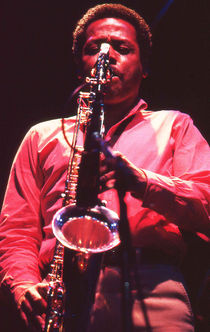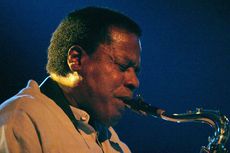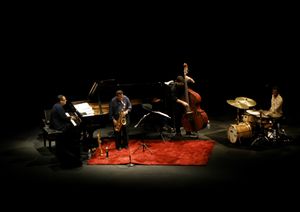Wayne Shorter
| Wayne Shorter | |
|---|---|
.jpg) Convocation Hall, Toronto, Nov. 27, 1977. Photo courtesy of Jean-Luc Ourlin |
|
| Background information | |
| Born | August 25, 1933 Newark, New Jersey, United States |
| Genres | Modal jazz, crossover jazz, post-bop, hard bop, jazz fusion |
| Occupations | Musician, composer |
| Instruments | Saxophone |
| Years active | 1959 – present |
| Labels | Blue Note, Columbia, Verve |
| Associated acts | Art Blakey, Miles Davis, Weather Report |
Wayne Shorter (born August 25, 1933) is an American jazz saxophonist and composer, commonly regarded as one of the most important American jazz musicians of his generation. His efforts have arguably made him a household name amongst jazz fans around the world, and won him honors and recognition, including multiple Grammy Awards.[1]
Shorter has recorded over 20 albums as a leader, and appeared on dozens more with others including Art Blakey's Jazz Messengers in the late 1950s, Miles Davis's second great quintet in the 1960s and the jazz fusion band Weather Report, which Shorter co-led in the 1970s. Many of his compositions have become standards.
Contents |
Biography
Early life and career
Shorter was born in Newark, New Jersey, and attended Newark Arts High School.[2] He loved music, being encouraged by his father to take up the saxophone as a teenager (his brother Alan became a trumpeter). After graduating from New York University in 1956, Shorter spent two years in the U.S. Army, during which time he played briefly with Horace Silver. After his discharge from the army, he played with Maynard Ferguson. It was in his youth that Shorter was given the nickname Mr. Gone, which would later become an album title for Weather Report.[3]
In 1959, Shorter joined Art Blakey. He stayed with Blakey for five years, and eventually became musical director for the group.
With Miles Davis (1964-1970)
When John Coltrane finally left Miles Davis' band in 1960 to pursue his own group (after previously trying to leave in 1959), Coltrane proposed Wayne Shorter as a replacement but Shorter was unavailable and Davis went with Sonny Stitt on tenor followed by a revolving door of Hank Mobley, George Coleman, and Sam Rivers. In 1964, Miles Davis persuaded Shorter to leave Blakey and join his quintet alongside Herbie Hancock, Ron Carter and Tony Williams.
Miles' so-called "second great quintet" (to distinguish it from the quintet with Coltrane) that included Hancock and Shorter has frequently been cited by musicians and critics as one of the most influential groups in the history of jazz, and Shorter's compositions are a primary reason for the group's unique sound. Shorter composed extensively for Miles Davis (e.g. "Prince of Darkness", "E.S.P.", "Footprints", "Sanctuary", "Nefertiti", and many others); on some albums, he provided half of the compositions, typically hard-bop workouts with spaced-out long melody lines above the beat.
Herbie Hancock said of Shorter's tenure in the group, "The master writer to me, in that group, was Wayne Shorter. He still is a master. Wayne was one of the few people who brought music to Miles that didn't get changed." Davis said, "Wayne is a real composer. He writes scores, write the parts for everybody just as he wants them to sound... Wayne also brought in a kind of curiosity about working with musical rules. If they didn't work, then he broke them, but with musical sense; he understood that freedom in music was the ability to know the rules in order to bend them to your own satisfaction and taste."[4]
Shorter remained in Davis's band after the breakup of the quintet in 1968, playing on early jazz fusion recordings including In a Silent Way and Bitches Brew (both 1969). His last live dates and studio recordings with Davis were in 1970.
Until 1968, he played tenor saxophone exclusively. The final album on which he played tenor in the regular sequence of Davis albums was Filles de Kilimanjaro. In 1969, he played the soprano saxophone on the Davis album In a Silent Way and on his own Super Nova (recorded with then-current Davis sidemen Chick Corea and John McLaughlin). When performing live with Miles Davis, recordings from summer 1969 to early spring 1970 he played both soprano and tenor saxophones. By the early 1970s, however, he chiefly played soprano saxophone.
Solo Blue Note recordings
Simultaneous with his time in the Miles Davis quintet, Shorter recorded several albums for Blue Note Records, featuring almost exclusively his own compositions, with a variety of line-ups, quartets and larger groups including Blue Note favourites such as Freddie Hubbard. His first Blue Note album (of nine in total) was Night Dreamer recorded at Rudy Van Gelder's studio in 1964 with Lee Morgan, McCoy Tyner, Reggie Workman and Elvin Jones.
JuJu and Speak No Evil are well known recordings from this era. Shorter's compositions on these albums are notable for their use of:
- pentatonic melodies harmonised with pedal points and complex harmonic relationships;
- structured solos that reflect the composition's melody as much as its harmony;
- long rests as an integral part of the music, in contrast with other, more effusive, players of the time such as John Coltrane.
The later album The All Seeing Eye was a free-jazz workout with a larger group, while Adams Apple of 1966 was back to carefully constructed melodies by Shorter leading a quartet. Then a sextet again in the following year for Schizophrenia with his Miles Davis band mates Hancock and Carter plus trombonist Curtis Fuller, alto saxophonist/flautist James Spaulding and strong rhythms by drummer Joe Chambers. These albums have recently been remastered by Rudy Van Gelder.
Shorter also recorded occasionally as a sideman (again, mainly for Blue Note) with Donald Byrd, McCoy Tyner, Grachan Moncur III, Freddie Hubbard, Lee Morgan, and bandmates Hancock and Williams.
Weather Report (1971-1985)

Following the release of Odyssey of Iska in 1970, Shorter along with keyboardist Joe Zawinul (also a veteran of the Miles Davis group) formed the fusion group Weather Report. The other original members were bassist Miroslav Vitous, percussionist Airto Moreira, and drummer Alphonse Mouzon. After Vitous' departure in 1973, Shorter and Zawinul co-led the group until the band's break-up in late 1985. A great variety of excellent musicians that would make up Weather Report alumni over the years (most notably the revolutionary bassist Jaco Pastorius) helped the band produce many high quality recordings in varying styles through the years — with funk, bebop, Latin jazz, ethnic music, and futurism being the most prevalent denominators.
Solo
Shorter also recorded critically acclaimed albums as a bandleader, notably Native Dancer, which featured his Miles Davis band-mate Herbie Hancock and Brazilian composer and vocalist Milton Nascimento. Shorter was to work with both of these musicians again later.
On the title track of Steely Dan's 1977 album Aja, he played a solo that moved the critic writing the album's liner notes to the point that he called it "suitable for framing" (meaning 'beautiful' rather than 'wooden').
Concurrently, in the late 1970s and the early 1980s, he toured in the V.S.O.P. quintet. This group was a revival of the 1960s Miles Davis quintet, except that Freddie Hubbard filled the trumpet chair instead of Miles. Shorter appeared with the same former Davis bandmates on the Carlos Santana double LP The Swing of Delight, for which he also composed a number of pieces.
His guest spots with Joni Mitchell on her LPs in the 1970s and 80s gained him a wider audience. He appeared with Hancock, Pastorius and Peter Erskine on Mitchell's Mingus album.

Recent career
After leaving Weather Report, Shorter continued to record and lead groups in jazz fusion styles, including touring in 1988 with guitarist Carlos Santana, who appeared on the last Weather Report disc This is This!. In 1989, he contributed to a hit on the rock charts, playing the sax solo on Don Henley's song "The End of the Innocence". He has also maintained an occasional working relationship with Herbie Hancock, including a tribute album recorded shortly after Davis's death with Hancock, Carter, Williams and Wallace Roney. He continued to appear on Joni Mitchell's records in the 1990s. Shorter's distinctive sound is also apparent in the soundtrack for the Harrison Ford film The Fugitive released in 1993.
In 1995, Shorter released the album High Life, his first solo recording for seven years. It was also Shorter's debut as a leader for Verve Records. Shorter composed all the compositions on the album and co-produced it with the bassist Marcus Miller. High Life received the Grammy Award for best Contemporary Jazz Album in 1997.
Shorter would work with Hancock once again in 1997, on the much acclaimed and heralded album 1+1. The song "Aung San Suu Kyi" (named for the Burmese pro-democracy activist) won both Hancock and Shorter a Grammy Award.
In 2009, he was announced as one of the headline acts at the Gnaoua World Music Festival in Essaouira, Morocco.
Quartet

Shorter formed his current band in 2000, the first permanent acoustic group under his leadership, a quartet with young musicians, pianist Danilo Perez, bassist John Patitucci, and drummer Brian Blade, playing his own complex compositions, many of them reworkings of tunes from his substantial portfolio going back to the 1960s. Two albums of live recordings featuring this quartet have been released, Footprints Live! (2002) and Beyond the Sound Barrier (2005). The quartet has received great acclaim from fans and critics, especially for the strength of Shorter's tenor saxophone playing. The Shorter biography Footprints by journalist Michelle Mercer contains an insight into the working life of these musicians as well as insight into Shorter's life, thoughts and Buddhist beliefs. Beyond the Sound Barrier received the 2006 Grammy Award for Best Instrumental Jazz Album.
Shorter's 2003 album Alegría (his first studio album for ten years, since High Life) received the 2004 Grammy Award for Best Instrumental Jazz Album; it features the quartet with a host of other musicians, including pianist Brad Mehldau, drummer Terri Lyne Carrington and former Weather Report percussionist Alex Acuña. Shorter's compositions, some new, some reworked from his Miles Davis period, feature the complex Latin rhythms that Shorter specialised in during his Weather Report days.
Personal life
Shorter married Teruka (Irene) Nakagami, in the 1960s; they met in 1961 and later had a child, Miyako.[5] Some of his compositions are copyrighted as "Miyako Music". Shorter dedicated some pieces to his daughter: "Miyako" and "Infant Eyes". The couple separated in 1964.[6]
Shorter met Ana Maria in 1964 and they were married in 1970.[6] Ana Maria and the couple's niece Dalila were both killed in 1996 on TWA Flight 800 while en route to see him in Italy.[6] Shorter married Carolina Dos Santos, a close friend of Ana Maria, in 1999. He is a Nichiren Buddhist and a member of Sōka Gakkai.[6]
Discography
| Title | Year | Label | ||
|---|---|---|---|---|
| Introducing Wayne Shorter | 1959 | Vee-Jay | ||
| Second Genesis | 1960 | Vee-Jay | ||
| Wayning Moments | 1962 | Vee-Jay | ||
| Night Dreamer | 1964 | Blue Note | ||
| JuJu | 1964 | Blue Note | ||
| Speak No Evil | 1965 | Blue Note | ||
| The Soothsayer | 1965 | Blue Note | ||
| Et Cetera | 1965 | Blue Note | ||
| The All Seeing Eye | 1965 | Blue Note | ||
| Adam's Apple | 1966 | Blue Note | ||
| Schizophrenia | 1967 | Blue Note | ||
| Super Nova | 1969 | Blue Note | ||
| Moto Grosso Feio | 1970 | Blue Note | ||
| Odyssey of Iska | 1970 | Blue Note | ||
| Native Dancer with Milton Nascimento | 1974 | Columbia | ||
| Atlantis | 1985 | Columbia | ||
| Phantom Navigator | 1986 | Columbia | ||
| Joy Ryder | 1988 | Columbia | ||
| Carlos Santana and Wayne Shorter - Live at the Montreux Jazz Festival 1988 with Carlos Santana | 1988 | Image Entertainment | ||
| High Life | 1995 | Verve | ||
| 1 + 1 with Herbie Hancock | 1997 | Verve | ||
| Footprints Live! | 2002 | Verve | ||
| Alegría | 2003 | Verve | ||
| Beyond the Sound Barrier | 2005 | Verve |
Awards
- Down Beat Poll Winner New Star Saxophonist (1962)
- Grammy Award for Best Jazz Fusion Performance for Weather Report's 8:30 (1979)
- Grammy Award for Best Instrumental Composition for Dexter Gordon's Call Sheet Blues (1987)
- Grammy Award for Best Jazz Instrumental Performance, Individual or Group for A Tribute to Miles (1994)
- Grammy Award for Best Contemporary Jazz Album for High Life (1996)
- Grammy Award for Best Instrumental Composition for Aung San Suu Kyi (1997)
- NEA Jazz Masters (1998)
- Honorary Doctorate of Music (1999; Berklee College of Music)
- Grammy Award for Best Jazz Instrumental Solo for In Walked Wayne (1999)
- Grammy Award for Best Instrumental Composition for Sacajawea (2003)
- Grammy Award for Best Jazz Instrumental Performance, Individual or Group for Alegría (2003)
- Grammy Award for Best Jazz Instrumental Performance, Individual or Group for Beyond The Sound Barrier (2005)
- Jazz Journalists Association Jazz Award Small Ensemble Group of the Year to Wayne Shorter Quartet (2006)
References
- ↑ The New York Times: "Times Topics" listing
- ↑ A Brief History, Newark Arts High School. Accessed August 10, 2008.
- ↑ The Big Takeover: Weather Report - Forecast: Tomorrow (Columbia Legacy) :
- ↑ Davis, Miles; Troupe, Quincy (1990). Miles: The Autobiography. Simon and Schuster. p. 274. ISBN 0671725823.
- ↑ http://100greatestjazzalbums.blogspot.com/2006/07/speak-no-evil-wayne-shorter-blue-note.html
- ↑ 6.0 6.1 6.2 6.3 "A Separate Peacee". People. http://www.people.com/people/archive/article/0,,20122768,00.html. Retrieved 2010-02-21.
Sources
- Michelle Mercer, Footprints: The Life and Work of Wayne Shorter (Tarcher/Penguin, 2005)
External links
- Essay on Wayne Shorter (Internet archive copy from February 2008)
- "An Interview with Wayne Shorter" by Bob Blumenthal, (Jazz.com).
- The Complete Wayne Shorter
- Wayne Shorter's letter read during Joe Zawinul's funeral
- Wayne Shorter discography
- Wayne Shorter Quartet with NEC Philharmonia, Boston on AllAboutJazz.com
|
|||||||||||||||||||||||